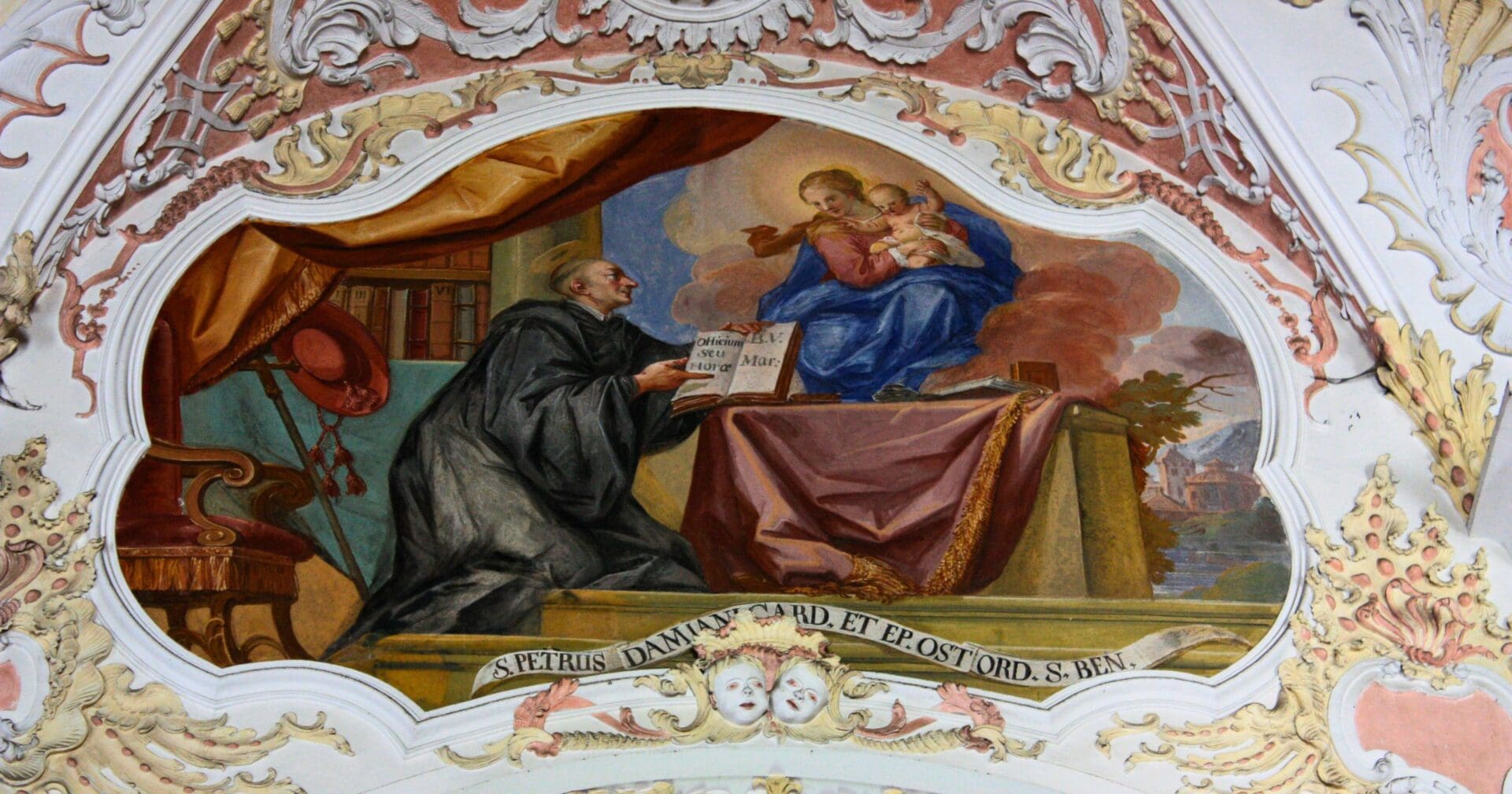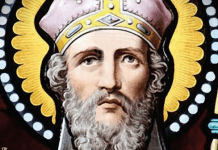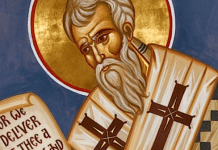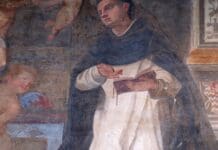Saint Peter Damian, born in the year 988 into a noble yet impoverished family, was the youngest sibling among many. His arrival sparked such concern over the family’s limited resources that his mother initially refused to nurse him, nearly resulting in his death. Thankfully, a compassionate servant intervened, nourishing the infant and guiding his mother back to her maternal responsibilities. After losing his parents at a young age, Peter experienced a challenging childhood; initially taken in by an elder brother who mistreated him and made him tend to swine. However, his fortunes changed when another brother, an archpriest in Ravenna, took him under his care, providing Peter with an education and eventually leading him to become a professor.
Peter Damian was known for his ascetic practices from early on, including wearing a hair shirt, fasting extensively, and dedicating long hours to prayer. His deep spiritual dedication led him to join the Benedictines under the reformative vision of St. Romuald at Fonte Avellana, where monks lived in pairs within hermitages. Peter’s zeal for prayer was so intense that it resulted in significant insomnia, teaching him the importance of self-care alongside his spiritual commitments. Beyond prayer, he immersed himself in Biblical studies.
When the abbot of Fonte Avellana passed away, Peter was appointed his successor, going on to establish five additional hermitages. He fostered a contemplative life among his fellow monks, valuing solitude and prayer above all. Despite his preference for a reclusive life, the Church frequently sought his diplomatic skills for resolving conflicts within its ranks or with secular authorities.
His reputation for integrity and zeal caught the attention of Pope Stephen IX, who appointed him as the cardinal-bishop of Ostia. In this role, Peter Damian fought against the corrupt practice of simony, advocated for clerical celibacy, and encouraged communal life and regular religious observance among clergy. He championed a return to the austere discipline of the early Church, critiquing any laxity in religious practice, even addressing minor infractions such as sitting during the singing of psalms.
Peter Damian was a prolific writer, leaving behind a significant corpus including 170 letters, 53 sermons, and several biographies that preferred narrative over theoretical exposition. His contributions to liturgical writing also showcased his mastery of Latin.
Despite his influential position, Peter often requested to return to monastic life, a wish that was eventually granted by Pope Alexander II. Yet, even in retirement, he continued to serve the Church as a papal legate. On a return journey from such a mission in Ravenna, he succumbed to a fever and passed away on February 22, 1072, surrounded by monks reciting the Divine Office. His enduring legacy was recognized in 1828 when he was declared a Doctor of the Church, a testament to his profound impact on Christian theology and monastic practice.
Photo credit: Public Domain via Wikimedia Commons


















[…] Джерела: saints.katolik.ru / brewiarz.katolik.pl / ucatholic.com […]
We are looking for potential candidates , who are ready to work for us from home. Job : Data Entry . Location: Work from home. Salary Show Inside:… u Work time : Any flexible time is fine.
Here …. https://SalaryTime62.blogspot.com
It is through suffering we often find strength in ourselves and our Father.
Oh Lord Jesus Christ, please grant us the gift of reverence toward you and your Holy Spirit.
Thank you for highlighting this Camaldolese Benedictine luminary. The church is stronger for his characteristic witness.
Complaints from Damian about the church’s unwillingness to confront the sexual behavior of the clergy, however, met with inaction. In 1049 Damian wrote to Pope Leo IX (1048-54) about the cancer of sexual abuse that was spreading through the church: boys and adolescents were being forced and seduced into performing acts of sodomy by priests and bishops; there were problems with sexual harassment among higher clergy; and many members of the clergy were keeping concubines.
Peter Damian warned the pope that bishops were contributing to the growth of the problem by their failure to enforce church discipline. Members of the clergy who sexually abused others demonstrated by their actions that they had no fear of God, Damian argued. Such men were afraid only of being despised by the people and of losing their positions; they would do anything to avoid being stripped of their clerical status and identity. Knowing that their bishop would not remove them from their office and ministry gave such men license to continue in their wickedness. Thus in failing to discipline abusive members of the clergy, the bishops stood as guilty as the men who committed the crimes.
Convinced that it was the lack of episcopal leadership that was causing the sexual abuse scandal in his day, Damian offered this admonition:
Listen, you do-nothing superiors of clerics and priests. Listen, and even though you feel sure of yourselves, tremble at the thought that you are partners in the guilt of others; those, I mean, who wink at the sins of their subjects that need correction and who by ill-considered silence allow them license to sin. Listen, I say, and be shrewd enough to understand that all of you alike are deserving of death, that is, not only those who do such things, but also they who approve those who practice them (Rom 1:32).
Drawing on the model that the bishop or priest is married to the church, Damian accused both those who sexually abused the people under their care and those who allowed such abuse to take place with the crime of spiritual incest. But whereas biological parents who committed incest were subject in the Middle Ages to excommunication and exile, Damian felt that bishops who betrayed their spiritual children deserved a harsher penalty. Their betrayal ran deeper.
Unfortunately, Pope Leo IX disagreed with Peter Damian’s analysis of the problem of clerical sexual abuse. He was willing to punish clerics who committed acts of anal intercourse with boys and adolescents, but he minimized the punishment of clerics who performed other sexual acts with children and adults of both sexes.
Shortly after the election of Pope Nicholas II (1058-61), Damian called attention to the issue again. His complaint to the new pope has a modern sound: Indeed, in our day the genuine custom of the Roman Church seems to be observed in this way, that regarding other practices of ecclesiastical discipline, a proper investigation is held; but a prudent silence is maintained concerning clerical sexuality for fear of insults from the laity. Damian urged the pope to bring the issue out into the open and to punish both the sexual offenders and the bishops who failed in their duty to punish and to depose sexual predators. He complained that occasionally priests were disciplined, but with bishops we pay our reverence with silent tolerance, which is totally absurd.
According to Damian, punishing those who hold positions of authority and oversight is the only way to restore credibility in times of scandal. Damian recounted the story of the Old Testament priest Phinehas. Finding one of the most prominent Israelite chiefs having sex with a Midianite prostitute, Phinehas exposed the pair to the people as they were having sex and skewered them with a spear. By this action Phinehas imitated God’s justice and sent the message that the laws would be enforced.
Damian notes that most of the Israelite men around Phinehas were consorting with prostitutes. Yet Phinehas struck down only the most powerful and socially prominent offenders. The conclusion to be drawn is that the powerful should be held to a higher standard. Thus in Nm 25:4, when Eli failed to punish his son, God struck him down. His inaction brought the priesthood into disrepute. Likewise, Damian asserted, when the magisterial hierarchy fails to enforce discipline, they undermine the legitimacy of the ecclesiastical office.
Eli was stripped of his power, privileges and wealth. Damian believed the bishops should also lose the trappings of episcopal office. He predicted that God’s agents for stripping the bishops of the wealth and privileges they had taken for granted would be the laity. The laity had granted the clergy temporal authority and wealth; so when the clergy failed in their spiritual mission, it was the laity that had the duty to take these things back, in collaboration with reformers in the clergy and religious orders.
Women held the lowest place in the church during the 11th century, but Damian believed that they too had a duty to correct the clergy. Their inclusion by him in the process of reforming even the highest members of the clergy illustrates Damian’s view that all in the church have the duty to correct their superiors publicly when they see serious sin or deviations from tradition. Virtue and power were not determined by a person’s sex. Rather, virtue is a gift from God.
So in 1064 Damian wrote to Duchess Adelaide of Turin, urging her to use her political power to address problems related to clerical sexual abuse. Using language that may seem offensive to us, he praised God for making Adelaide as strong as a man and drew upon a host of biblical citations, including the examples of Deborah, Jael, Judith, Esther, Abigail and other women who corrected and punished weak, evil or fearful men, to justify her action in reforming the male members of the clergy. The scriptural stories proved that God sometimes chooses women to be instruments of a more glorious triumph.
At the very least, Damian’s story calls into question the practice of covering up sins as a means to avoid scandal. It also provides a road map for church leaders to recover credibility by disciplining the bishops who have enabled sexual predators to damage the most vulnerable members of the people of God. And if the magisterial hierarchy proves unable to reform itself on these matters, St. Peter Damian offers a Catholic model of collaborative reform that includes the laity, religious, deacons and priests. Most important, his story shows that we have overcome sexual abuse scandals in the past by upholding faithfulness to our tradition and maintaining vigilance against corruption.
Wow. If only Pope Leo had done something in 1049?! Crazy that some priests didn’t have fear of the Lord. Thank you for sharing this enlightening information. St. Peter Damian was a man of great wisdom.
St. Peter Damian, pray for us.
[…] post Saint Peter Damian, Doctor of the Church appeared first on […]
Saint Peter Damian, Doctor of the Church, pray for us!
St. Peter Damian, pray for all of us.
All-powerful God,
help us to follow the teachings and example of Peter Damian.
By making Christ and the service of his Church
the first love of our lives,
may we come to the joys of eternal light,
where he lives and reigns with you
in the unity of the Holy Spirit,
one God, for ever and ever.
Amen.
St. Peter Damian, help to more fervent priests.
St. Peter Damian, pray for the Church and Pope.
Saint Peter Damian, pray for us amen
internet jobs are a growing industry and an exciting opportunity, saving time and money for both businesses and employees alike. Flexible work, whether full-time or casual jobs, are available in virtually every industry – you just need to know where to look. Here Look…… https://hrwork11.blogspot.com